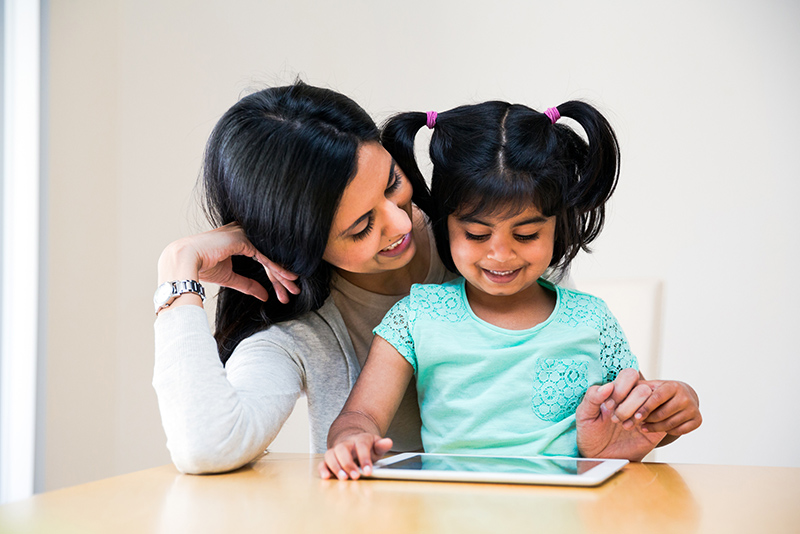Families For Life | Internet Safety: Children 3-5 Years

The internet can entertain, educate and occupy your pre-schooler. But your child can come across dangerous people or inappropriate content online. With some practical internet safety precautions, you can minimise the risks for your child.
Why internet safety matters
Pre-schoolers like going online to look at videos or to play games. They can do this using computers, mobile phones, tablets, TVs and other devices.
There are safety risks for preschoolers online, although preschoolers won’t usually be exposed to as many risks as older children because they’re less likely to be browsing the internet independently.
When you take some practical internet safety precautions, you protect your child from risky or inappropriate content and activities. And your child gets to make the most of her online experience, with its potential for learning, exploring, being creative and connecting with others.
Internet safety risks for pre-schoolers
There are four kinds of internet safety risks for children:
Content risks: these risks include content that children might find upsetting, disgusting or otherwise uncomfortable. Examples are pornography, violence, images of cruelty to animals or programmes meant for older children.
Contact risks: these risks include children coming into contact with people they don’t know. For example, a child might use a communication app and talk to a stranger.
Conduct risks: these risks include children acting in ways that might hurt others. For example, a child might destroy a game his friend or sibling has created. Accidentally making in-app purchases is another conduct risk.
Contract risks: these risks include children signing up to unfair contracts, memberships or terms and conditions that they aren’t aware of or don’t understand. For example, children might click a button that allows a business to send them inappropriate marketing messages or collect their personal or family data.
Protecting your child from internet safety risks: tips
You play a key role in reducing the risks that your child is exposed to on the internet. There are many practical things you can do to help keep your pre-schooler safe while she’s online.
Here are some ideas:
Use the internet with your child or make sure you’re close by and aware of what your child is doing while he’s online. This way you can act quickly if your child is concerned or upset by something he’s seen.
Create a family media plan. Your plan could cover things like screen-free areas in your house, internet safety rules like not giving out personal information, and the programmes, games and apps that are OK for your child to use.
Use child-friendly search engines like Kiddle, or content providers like KIDOZ, Okto or YouTube Kids.
Check that games, websites and TV programmes are appropriate for your child. For example, you can look at reviews on Common Sense Media.
Make sure older siblings follow your internet safety rules when they go online with your pre-schooler. Rules might include watching only age-appropriate programmes.
Set up a folder with bookmarks for your child’s favourite apps or websites so that she can easily find them. You can set up folders and bookmarks on all the devices that your child uses.
Check privacy settings, use parental controls, block in-app purchases, disable one-click payment options on your devices, and find out how to make complaints about offensive online content.
As your child gets older and more confident and starts to use the internet independently, you’ll need to review your strategies. Our article on internet safety for children aged 6-8 years has tips.
Teaching safe and responsible online behaviour
You can help your child learn how to use the internet safely, responsibly and enjoyably. If you teach your child how to manage internet safety risks and worrying experiences for himself, he’ll build digital resilience. This is the ability to deal with and respond positively to any risks he encounters online.
Here are some ideas:
Be a good role model. Your child learns from you. This means you can model safe and healthy internet use by using the internet in the way you want your child to use it – for example, by not having internet-connected devices in bedrooms.
Explain to your child that there’s good and bad content on the internet, including content that isn’t true. Encourage your child to talk to you if she sees something upsetting, scary or worrying. For example, you could say, ‘Some videos on the internet can be upsetting or scary. Tell me if you see something that scares you or makes you feel uncomfortable’.
Spend time online with your child. Get him to show you websites that are fun or interesting, ask him to show you how to play the app or game that he’s playing, or talk about the videos he’s watching. If you think the app or video isn’t appropriate, you could say, ‘This is a bit grown-up. Let’s find something else’. Then help your child to find something more appropriate.
Explain to your child about in-app purchases and pop-up advertisements. For example, you could say, ‘People use the internet to make money and we have to be careful that we don’t give them our money by mistake. If something pops up on the screen don’t click it. Come and tell me’.
It’s also a good idea to find out how grandparents and other people in your child’s life use the internet and try to agree on a shared approach.
It’s okay if your rules are different from those of other families. If you’ve thought them through and you’re happy with the way they’re working, you’re helping to keep your child safe online.
© raisingchildren.net.au, translated and adapted with permission
Explore more

DID YOU KNOW?
Bath time is a good way to soothe your baby but it can also be a fantastic learning opportunity for your child. Learn how you can engage him during bath time.
READ MORE